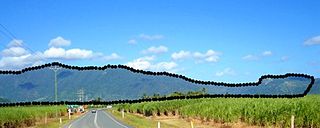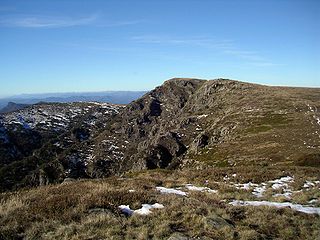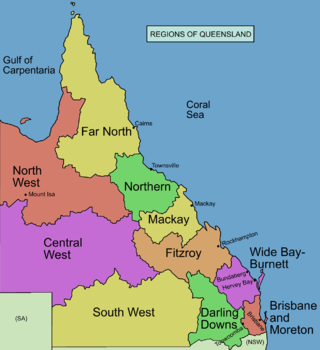Related Research Articles

The Northern Territory is an Australian territory in the central and central northern regions of Australia. The Northern Territory shares its borders with Western Australia to the west, South Australia to the south, and Queensland to the east. To the north, the territory looks out to the Timor Sea, the Arafura Sea and the Gulf of Carpentaria, including Western New Guinea and other islands of the Indonesian archipelago.

Australian Aboriginal religion and mythology is the sacred spirituality represented in the stories performed by Aboriginal Australians within each of the language groups across Australia in their ceremonies. Aboriginal spirituality includes the Dreamtime, songlines, and Aboriginal oral literature.
The Pilbara is a large, dry, thinly populated region in the north of Western Australia. It is known for its Aboriginal peoples; its ancient landscapes; the red earth; and its vast mineral deposits, in particular iron ore. It is also a global biodiversity hotspot for subterranean fauna.

The Wangal people are a clan of the Dharug Aboriginal people whose heirs are custodians of the lands and waters of what is now the Inner West of Sydney, New South Wales, centred around the Municipality of Strathfield, Municipality of Burwood, City of Canada Bay and former Ashfield Council and extending west into the City of Parramatta.

The Pitjantjatjara are an Aboriginal people of the Central Australian desert near Uluru. They are closely related to the Yankunytjatjara and Ngaanyatjarra and their languages are, to a large extent, mutually intelligible.
Ngunnawal/Ngunawal and Gundungurra are Australian Aboriginal languages, and the traditional languages of the Ngunnawal and Gandangarra. Ngunnawal and Gundungurra are very closely related and the two were most likely highly mutually intelligible. As such they can be considered dialects of a single unnamed language, but this is the technical linguistic usage of these terms and Ngunnawal and Gundungurra peoples prefer to describe their individual varieties as separate languages in their own right.
Linley Margaret Frame, is an Australian competitive swimmer who won a gold medal in the 100-metre breaststroke at the 1991 FINA World Aquatics Championships, and represented Australia at the 1992 Summer Olympics in Barcelona, coming in 15th and 19th in her breaststroke events.

Mount Howitt, also known as Toot-buck-nulluck in the Gunai language, is a mountain in Victoria, Australia, named for Alfred William Howitt. Located in the Wonangatta Moroka Unit of the Alpine National Park approximately 170 km north-east of Melbourne.

New Mapoon is a town in the Northern Peninsula Area Region and coastal locality split between the Northern Peninsula Region and Shire of Torres, Queensland, Australia. In the 2016 census, New Mapoon had a population of 383 people.
Indigenous Australian self-determination, also known as Aboriginal Australian self-determination, is the power relating to self-governance by Aboriginal and Torres Strait Islander peoples in Australia. It is the right of Aboriginal and Torres Strait Islander peoples to determine their own political status and pursue their own economic, social and cultural interests. Self-determination asserts that Aboriginal and Torres Strait Islander peoples should direct and implement Aboriginal and Torres Strait Islander policy formulation and provision of services. Self-determination encompasses both Aboriginal land rights and self-governance, and may also be supported by a treaty between a government and an Indigenous group in Australia.
Australian Aboriginal culture includes a number of practices and ceremonies centered on a belief in the Dreamtime and other mythology. Reverence and respect for the land and oral traditions are emphasised. Over 300 languages and other groupings have developed a wide range of individual cultures. Due the colonization of Australia under terra nullius concept these cultures were treated as one monoculture. Australian Aboriginal art has existed for thousands of years and ranges from ancient rock art to modern watercolour landscapes. Aboriginal music has developed a number of unique instruments. Contemporary Australian Aboriginal music spans many genres. Aboriginal peoples did not develop a system of writing before colonisation, but there was a huge variety of languages, including sign languages.

The Gulf Country or North West Queensland is the region of woodland and savanna grassland surrounding the Gulf of Carpentaria in north western Queensland and eastern Northern Territory on the north coast of Australia. The region is also called the Gulf Savannah. The Gulf Country is crossed by the Savannah Way highway.
Indigenous Australians are both convicted of crimes and imprisoned at a disproportionately higher rate in Australia, as well as being over-represented as victims of crime. As of September 2019, Aboriginal and Torres Strait Islander prisoners represented 28% of the total adult prisoner population, while accounting for 2% of the general adult population. Various explanations have been given for this over-representation, both historical and more recent. Federal and state governments and Indigenous groups have responded with various analyses, programs and measures.

A Registered Aboriginal Party (RAP) is a recognised representative body of an Aboriginal Australian people per the Aboriginal Heritage Act 2006 (Vic.), whose function is to protect and manage the Aboriginal cultural heritage in the state of Victoria in Australia.
The Coleman River is a river on the Cape York Peninsula in Far North Queensland, Australia.
Cobaki Lakes is a suburb of Tweed Heads, located in the Northern Rivers Region of New South Wales, along the Queensland and New South Wales border.
The Ngardi, also spelled Ngarti, are an Aboriginal Australian people of the Northern Territory and Western Australia.

The Bindal are the Aboriginal Australian people whose ancestors originally possessed, occupied, used and enjoyed approximately 2600 km2 of coastal country from the mouth of the Burdekin River north to Cape Cleveland, inland to Leichhardt Range, in the state of Queensland
Gagalba is a rural locality in the Sunshine Coast Region, Queensland, Australia.

This article relates to historical and current separatist movements within Australia. Separatism conventionally refers to full political separation, including secessionism; groups simply seeking greater autonomy are not separatist as such.
References
- ↑ McManus, Bridget (17 March 2008). "Heart of our country". The Sydney Morning Herald . Retrieved 2 June 2011. (WebCite archive)
- ↑ Caring for Country: Aboriginal culture offers environmental wisdom, NOVA Magazine, May 2010. (WebCite archive)(Archive.today archive)